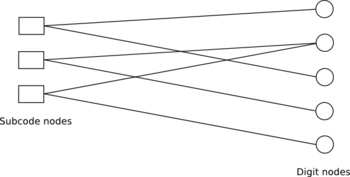In coding theory, a Tanner graph is a bipartite graph that can be used to express constraints (typically equations) that specify an error correcting code. Tanner graphs play a central role in the design and decoding of LDPC codes. They have also been applied to the construction of longer codes from smaller ones. Both encoders and decoders employ these graphs extensively.
Origins
Tanner graphs were proposed by Michael Tanner as a means to create larger error correcting codes from smaller ones using recursive techniques. He generalized the techniques of Elias for product codes.
Tanner discussed lower bounds on the codes obtained from these graphs irrespective of the specific characteristics of the codes which were being used to construct larger codes.
Tanner graphs for linear block codes

Tanner graphs are partitioned into subcode nodes and digit nodes. For linear block codes, the subcode nodes denote rows of the parity-check matrix H. The digit nodes represent the columns of the matrix H. An edge connects a subcode node to a digit node if a nonzero entry exists in the intersection of the corresponding row and column.
Bounds proven by Tanner
Tanner proved the following bounds
Let be the rate of the resulting linear code, let the degree of the digit nodes be and the degree of the subcode nodes be . If each subcode node is associated with a linear code (n,k) with rate r = k/n, then the rate of the code is bounded by
Computational complexity of Tanner graph based methods
The advantage of these recursive techniques is that they are computationally tractable. The coding algorithm for Tanner graphs is extremely efficient in practice, although it is not guaranteed to converge except for cycle-free graphs, which are known not to admit asymptotically good codes.
Applications of Tanner graph
Zemor's decoding algorithm, which is a recursive low-complexity approach to code construction, is based on Tanner graphs.
Notes
- R. Michael Tanner Professor of Computer Science, School of Engineering University of California, Santa Cruz Testimony before Representatives of the United States Copyright Office February 10, 1999
- T. Etzion, A. Trachtenberg, and A. Vardy, Which Codes have Cycle-Free Tanner Graphs?, IEEE Trans. Inf. Theory, 45:6.
 be the rate of the resulting linear code, let the degree of the digit nodes be
be the rate of the resulting linear code, let the degree of the digit nodes be  and the degree of the subcode nodes be
and the degree of the subcode nodes be  . If each subcode node is associated with a linear code (n,k) with rate r = k/n, then the rate of the code is bounded by
. If each subcode node is associated with a linear code (n,k) with rate r = k/n, then the rate of the code is bounded by
